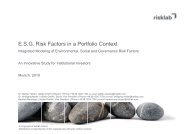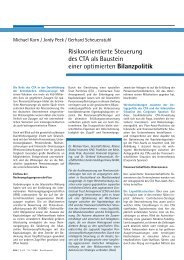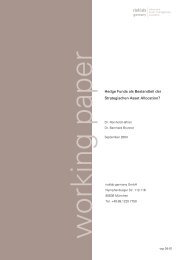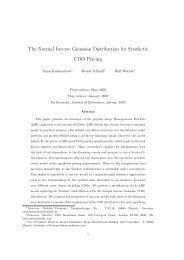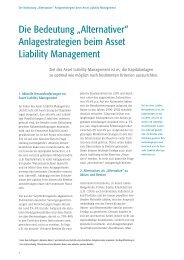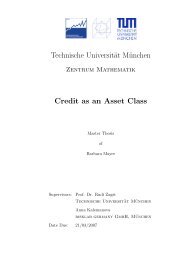Technical University Munich Commodities as an Asset Class - risklab
Technical University Munich Commodities as an Asset Class - risklab
Technical University Munich Commodities as an Asset Class - risklab
Create successful ePaper yourself
Turn your PDF publications into a flip-book with our unique Google optimized e-Paper software.
2.1 The different Commodity Types<br />
went to China in 2005. 24 Rising prices are highly correlated with a falling stock of<br />
inventory. Pushing production in metals markets is neither e<strong>as</strong>y nor quick. New<br />
mines have to be cultivated <strong>an</strong>d infr<strong>as</strong>tructure in processing <strong>an</strong>d tr<strong>an</strong>sportation<br />
h<strong>as</strong> to be built. This is mostly combined with environmental s<strong>an</strong>ctions which to<br />
get c<strong>an</strong> l<strong>as</strong>t for years, especially in industrial countries. Because of the low margins<br />
during the 1980th <strong>an</strong>d 1990th the industry didn’t invest yielding into capacity bottle<br />
necks at the beginning of the 21rst century followed by the biggest price surge in<br />
metals markets ever. Industry’s huge gains of the l<strong>as</strong>t five years were invested in <strong>an</strong><br />
acquisition relay, so that today only a couple of mining gi<strong>an</strong>ts, including Rio Tinto,<br />
BHP Billiton <strong>an</strong>d Anglo Americ<strong>an</strong>, rule the market. No other industry went through<br />
such a fundamental structural ch<strong>an</strong>ge. Buying other comp<strong>an</strong>ies me<strong>an</strong>s buying their<br />
mines <strong>an</strong>d knowing what you get for your money. Self exploration projects are by far<br />
more risky. But now where only the big survivors are left <strong>an</strong>d dem<strong>an</strong>d still exceeds<br />
production, the industry need to go down the traditional road: Rio Tinto will invest<br />
three billion US dollar in both years 2006 <strong>an</strong>d 2007. BHB Billion will invest 12<br />
billion in the exploration of new mines. But this c<strong>an</strong> l<strong>as</strong>t until five to ten years <strong>an</strong>d<br />
even more caused by the re<strong>as</strong>ons mentioned introductory to this section. 25<br />
Moreover, the industry faces further problems with machinery <strong>an</strong>d educated staff.<br />
While m<strong>an</strong>y geologists needed to drive taxi during the 1990th they account to the<br />
most questioned employees, today. The waiting times of Caterpillar, Komatsu <strong>an</strong>d<br />
Liebherr for the gi<strong>an</strong>t trucks, costing around three million US dollar <strong>an</strong>d needed to<br />
tr<strong>an</strong>sport the raw ores in the mining sites, are around 18 month <strong>an</strong>d were supplied<br />
partly without wheels because its producers Michelin <strong>an</strong>d Bridgestone are still afraid<br />
to extend their production.<br />
Although, there is no end in sight in metals reserves because not all mines are<br />
explored yet, putting all these factors together the agers for a long period of high<br />
metal prices is given. Appendix B.4 to B.8 will further give a small inside into the<br />
production <strong>an</strong>d consumption structure of some selected metals including aluminium,<br />
copper, lead, nickel <strong>an</strong>d zinc.<br />
2.1.3 Agricultures<br />
The agricultural market is the most heterogenous market of the three main commodity<br />
groups. Figure 2.1 introduced its three sub groups: softs, grains <strong>an</strong>d livestock.<br />
While energy <strong>an</strong>d metals already went through a huge price surge, agricultures, with<br />
24 See [<strong>Commodities</strong> 2006].<br />
25 See [<strong>Commodities</strong> 2006].<br />
21



